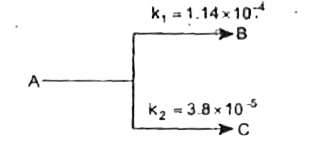A follows parallel path first order reaction to give B and C as given below (Take antilog (0.156)=1.428)

The concentratio of A after 5 hours is Solution in Telugu
3.6×x10−2M
6×10−2M
1.5×10−2M
1.39×10−1M
The correct Answer is:D
Assume that it is 1st order and find Ct=?K×t=2.303×log(C0Ct),Ct=0.139M
Topper's Solved these Questions
- CHEMICAL KINETICSBOOK - AAKASH SERIESCHAPTER - CHEMICAL KINETICSEXERCISE - PRACTICE SHEET-4 (MATCH THE FOLLOWING QUESTIONS)
2 Videos
- CHEMICAL KINETICSBOOK - AAKASH SERIESCHAPTER - CHEMICAL KINETICSEXERCISE - PRACTICE SHEET-4 (INTEGER ANSWER TYPE QUESTIONS)
6 Videos
- CHEMICAL KINETICSBOOK - AAKASH SERIESCHAPTER - CHEMICAL KINETICSEXERCISE - PRACTICE SHEET-4 (SINGLE OR MORE THAN ONE OPTION QUESTIONS)
16 Videos
- CHEMICAL KINETCSBOOK - AAKASH SERIESCHAPTER - CHEMICAL KINETCSEXERCISE - EXERCISE - 3.2
45 Videos
- CHEMICAL THERMODYNAMICSBOOK - AAKASH SERIESCHAPTER - CHEMICAL THERMODYNAMICSEXERCISE - Additional Practice Exercise
54 Videos
Similar Questions

View SolutionThe concentrationfo R in the reaction R→P was measured as a function of time and the following data is obtained:
[R] (molar) 1.0 0.75 0.40 0.10
t(min) 0.0 0.05 0.12 0.18
The order of the reactionis
View SolutionIn general the rate of a given reaction can be increased by all the factors except
View SolutionDiscuss on the kinetic spontaneity of a chemical reaction. Is a slow reaction spontaneous? Why?
View SolutionWhich among the following is not an exact differential?
View SolutionA follow parallel path of first-order reactions giving B and C as If the initial concentration of A is 0.25 M , calculate the concentration of C after 5 hr of reaction.
View SolutionA substance undergoes first order decomposition. The decomposition follows two parallel first order reaction as :

The precentage distribution of B and C are :
View SolutionFor a first order reaction A→B the rate constant is x min−1. If the initial concentration of A is 0.01 M, the concentration of A after one hour is given by the expression.
View SolutionA substance undergoes first order decomposition. The decomposition follows two parallel first order reactions as The % distribution of B and C is ................ and .................. respectively.
View SolutionA follows parallel path, first order reaction giving B and C as If initial concentration of A is 0.25M , calculate the concentration of C after 5 hours of reaction. [Given : k_(1)=1.5xx10^(-5)s^(-1) , k_(2)=5xx10^(-6)s^(-1)
View SolutionA substance undergoes a first order decomposition. The decomposition follows two parallel first order reactions as

The percentage distribution of B and C are
View Solution(क) एक प्रथम क्रम की अभिक्रिया को 75% पूरा होने में 60 मिनट लगता है। इस अभिक्रिया का अर्दजीवन काल निकाले|
(ख) शून्य क्रम और प्रथम कम अभिक्रियाओं का एक एक उदाहरण दे।
View SolutionConsider the following parallel reaction being given A(t_(1//2)=1.386xx10^(2)hrs) , each path being first order. If the distribution of B in the product mixture is 50%, the partial half life of A for conversion into C is
View SolutionA follows parallel path first order reaction to give B and C as given below (Take antilog (0.156)=1.428)

Initial conc of A is 0.2 M
The overall rate constant of the reaction is
View SolutionA follows parallel path first order reaction to give B and C as given below (Take antilog (0.156)=1.428)

At any stage of reaction molar yield of B in the products is
View Solution
